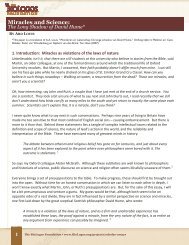What Scientists Do In this scholarly essay, Steve Benner - BioLogos
What Scientists Do In this scholarly essay, Steve Benner - BioLogos
What Scientists Do In this scholarly essay, Steve Benner - BioLogos
You also want an ePaper? Increase the reach of your titles
YUMPU automatically turns print PDFs into web optimized ePapers that Google loves.
The <strong>BioLogos</strong> Foundation • www.<strong>BioLogos</strong>.org/projects/scholar-<strong>essay</strong>s<br />
the proposition is "scientific" under the falsifiability demarcation criterion. Not a particularly interesting<br />
law, of course. But perhaps we can be satisfied that we are doing "real science".<br />
We can even express <strong>this</strong> in a syllogism that classical Greek philosophers would recognize (it is<br />
called the contrapositive). If an observed X is an emerald and X is not green, then the proposition is false.<br />
Unfortunately, things are not so simple in the real world of<br />
science. It turns out that whether or not an emerald is observed to<br />
be green depends on how it is observed, and who is doing the<br />
observing. For example, an emerald may be observed to fluoresce<br />
a red color when observed under ultraviolet light.<br />
No problem, you say.<br />
The proposition can be changed to read: "All emeralds are<br />
green when examined under white light". But even then, the<br />
falsification effort does not work if the observer has red-green<br />
colorblindness. We must further modify the proposition to read:<br />
"All emeralds are green when examined under white light by an<br />
observer who does not have red-green colorblindness".<br />
These modifications of the original law constitute ad hoc<br />
"auxiliary propositions". We invent them to explain away an<br />
observation that would otherwise appear to be falsifying. This type<br />
of thing seems to defeat the demarcation.<br />
We might say: Fine, scientists are not allowed to modify, ad hoc, propositions so that they survive<br />
observations that apparently falsify them. Unfortunately, it is not justifiable. We should protect<br />
propositions from certain contradicting observations. For example, we should not discard a theory if the<br />
observing instrument was broken at the time that it generated an allegedly contradicting observation.<br />
The creation of auxiliary propositions ad hoc must be done if one does not want to be paralyzed in<br />
building models for reality by the exigencies of real world experimentations and observations. Not<br />
surprisingly, the history that created the empowerments cited above is littered with ad hoc auxiliary<br />
propositions.<br />
And <strong>this</strong> is not even the half of it. The principal atoms in an emerald are oxygen, silicon, aluminum,<br />
and beryllium; an emerald is "beryllium aluminum silicate." Now, it is possible to drop on the table a rock<br />
that is substantially colorless beryllium aluminum silicate. "Aha!", you say. We have disproven the "law" by<br />
finding a non-green emerald. Not so fast. It turns out that mineralogists call colorless beryllium aluminum<br />
silicate "goshenite". Mineralogists call aqua-colored beryllium aluminum silicate "aquamarine". Emeralds<br />
are green only because they contain a trace of chromium. Thus, the proposition is easily lost in semantics.<br />
These problems become only worse when we move to more complex (and more interesting)<br />
scientific propositions, where many propositions are logically connected, including many that we do not<br />
even know that we are presuming. For example, it is widely accepted today that the Earth was formed<br />
about 4.5 billion years ago and that life has been present on Earth for the majority of the time since it<br />
formed.<br />
No problem today, perhaps, but it was a problem in the 19 th century as evolutionary theory was<br />
being developed. Biologists required hundreds of millions of years of Earth history to explain the observed<br />
diversity of life under a model of gradual evolution. Darwin himself used the record of sedimentary rocks to<br />
suggest that the Earth was at least 300 million years old.<br />
3<br />
<strong>What</strong> <strong>Scientists</strong> <strong>Do</strong><br />
BY STEVEN BENNER




